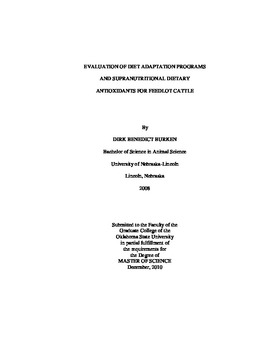| dc.contributor.advisor | Richards, Chris J. | |
| dc.contributor.author | Burken, Dirk Benedict | |
| dc.date.accessioned | 2014-04-15T20:12:40Z | |
| dc.date.available | 2014-04-15T20:12:40Z | |
| dc.date.issued | 2010-12-01 | |
| dc.identifier.uri | https://hdl.handle.net/11244/8798 | |
| dc.description.abstract | To evaluate feedlot performance and carcass characteristics of finishing beef steers fed diets containing wet distiller's grains with solubles (WDGS) and supplemented with vitamin E, one hundred ninety-nine steers (370 ± 32 kg) were blocked by BW and randomly assigned to 1 of 4 supplemental vitamin E (VITE) treatment levels (0, 125, 250, and 500 IU.steer-1.day-1) fed for the last 97 d of the feeding period. BW and ADG were not affected by VITE treatments. Carcass adjusted final weights resulted in a linear increase in ADG related to a tendency for a linear increase in carcass adjusted BW with increasing concentration of vitamin E supplementation. Pre-VITE and VITE period DMI were not affected by VITE treatments, but there was a trend for a linear increase in overall DMI with increased dietary vitamin E. No difference occurred in G:F measures using live weight gains, but G:F using carcass adjusted weight gains resulted in a trend for a linear increase with increasing dietary vitamin E. Hot carcass weight tended to increase linearly with increasing concentration of vitamin E. Vitamin E supplementation did not affect measured carcass characteristics. A second experiment compared feedlot performance, carcass characteristics, and intake variation of heifers adapted over 28 d to a 94% concentrate diet with 2 different adaptation programs. One hundred forty-four heifers (343 ± 41 kg; arrival 1) and 154 heifers (309 ± 35 kg; arrival 2) were blocked by BW and randomly assigned to either a two–ration blending (2RB) or traditional step-up (TRAD) grain adaptation program. There was no difference in DMI for any period tested. There was a tendency for 2RB heifers to have increased daily DMI variation during the period of d 0 to 6. Heifers on the 2RB program also had increased DMI variation from d 7 to 13. There were no treatment differences in daily DMI variation for all other periods tested. There were also no treatment differences for pen DMI variation. Daily ME intake for the periods of d 0 to 7, d 8 to 14, d 15 to 21, and d 22 to 28 were not different. The heifers on the TRAD treatment tended to have a greater daily ME intake from d 22 to 28. Daily ME intake for d 0 to 35 was not different. Body weight, ADG, and G:F data were not affected by grain adaptation program. Percentage of cattle grading USDA Prime, Choice, Select, or not graded did not differ, nor did percentage USDA Yield Grade 1, 2, 3, or 4. There was an increase in percentage of Choice- carcasses based on marbling score for the TRAD treatment along with a tendency for a lower proportion of carcasses not graded. Calculated yield grade did not differ between treatments. | |
| dc.format | application/pdf | |
| dc.language | en_US | |
| dc.publisher | Oklahoma State University | |
| dc.rights | Copyright is held by the author who has granted the Oklahoma State University Library the non-exclusive right to share this material in its institutional repository. Contact Digital Library Services at lib-dls@okstate.edu or 405-744-9161 for the permission policy on the use, reproduction or distribution of this material. | |
| dc.title | Evaluation of Diet Adaptation Programs and Supranutritional Dietary Antioxidants for Feedlot Cattle | |
| dc.type | text | |
| dc.contributor.committeeMember | Krehbiel, Clint R. | |
| dc.contributor.committeeMember | Step, D. L. | |
| osu.filename | Burken_okstate_0664M_11258.pdf | |
| osu.college | Agricultural Sciences and Natural Resources | |
| osu.accesstype | Open Access | |
| dc.description.department | Department of Animal Science | |
| dc.type.genre | Thesis | |
| dc.subject.keywords | beef | |
| dc.subject.keywords | carcass | |
| dc.subject.keywords | cattle | |
| dc.subject.keywords | feedlot | |
| dc.subject.keywords | growth | |
| dc.subject.keywords | vitamin e | |
